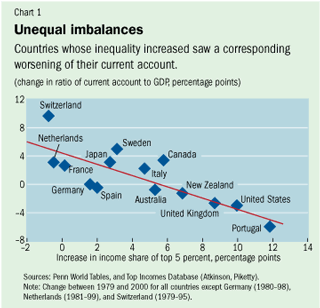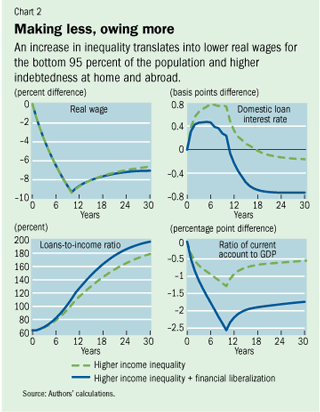Unequal = Indebted
Finance & Development, September 2011, Vol. 48, No. 3
Michael Kumhof and Romain Rancière
Higher income inequality in developed countries is associated with higher domestic and foreign indebtedness
ECONOMISTS have long worried about the growing chasm between countries that borrow heavily internationally and those that dish out the loans. They call it global current account imbalances and, especially since the onset of the global economic crisis in 2007, there has been concern that global markets could be destabilized were there a run on the currencies of those countries that pile up huge deficits. That hasn’t happened, at least so far. In fact, the biggest borrower of all, the United States, is viewed mainly as a safe haven by lenders.
But there is another, domestic dimension to the pileup of international obligations. Domestic debt rises too and could reach unsustainable levels that could lead to domestic financial crises.
Why the United States has built such persistent and large deficits in its current account—which covers all noninvestment international transactions, including exports and imports, dividends and interest, and remittancese—is a matter of some debate. Explanations include a low domestic saving rate, high foreign saving rates, high demand for high-yield U.S. assets from fast-growing but less financially developed countries, excess holding of international reserves in emerging market countries for both precautionary and mercantilist motives, demographics and productivity, and the role of the U.S. dollar as the world’s reserve currency. But the phenomenon of persistently high current account deficits is not limited to the United States; it has also been observed in a number of other developed economies, especially those in the English-speaking world.

In current research we therefore extend the work reported in “Leveraging Inequality” (F&D, December 2010), which dealt with only the United States, to include an open-economy dimension. We find (see Chart 1) that what unites the experiences of the main deficit countries is a steep increase in income inequality over recent decades, as measured by the share of income going to the richest 5 percent of the country’s income distribution.
This increase in inequality has contributed to a deterioration in the richest countries’ aggregate savings-investment balances, as the poor and middle class borrowed from the rich and from foreign lenders. This, along with the other factors mentioned above, can fuel current account deficits.
Indeed, we find that as income shares of the top 5 percent increased between the early 1980s and the end of the millennium, current account balances worsened. For example, in the United Kingdom, an 8.7 percentage point increase in the income share of the richest 5 percent was accompanied by a deterioration in the current account–to-GDP ratio of 2.7 percentage points.
Modeling the facts
An economic model can clearly illustrate these links between income inequality and current account deficits. In our model, based on an open-economy extension of Kumhof and Rancière (2010), households are divided into a top 5 percent income group (“top group”) and a bottom 95 percent income group (“bottom group”) in a medium-sized country that accounts for 5 percent of world GDP. Shares of aggregate income are determined by a bargaining process between the two groups.
The model assumes that the top group experiences a large and persistent favorable bargaining power shock that increases its share of the economy’s economic pie over an initial period of 10 yearse—with a corresponding decrease in the bottom group’s share. (Our research deals with only the macroeconomic consequences of higher observed inequality; the literature, as we surveyed in our earlier article, has identified a number of different reasons for this phenomenon.)
The top group derives satisfaction not only from consumptione—there is only so much a person who “has it all” can consumee—but also from accumulating wealth, including financial wealth, meaning loans to the bottom group. Part of the top group’s response to the hike in its income is therefore to increase loans to the bottom group. This allows the bottom group to continue consuming the economy’s output even though it is earning a significantly lower share of income. Consequently, credit supply from the top group and credit demand from the bottom group increase simultaneously. The probability of default by the bottom group is assumed to increase with the level of debt, which builds up over time, thereby leading to higher risk premiums.

As a result of the shock, our model shows a decline of about 9 percent in the real wage (relative to trend real wage growth), an initial increase in the domestic loan interest rate of 80 basis points, and an increase of almost 120 percentage points in the lower group’s debt-to-income ratio (see Chart 2, dashed line).
The increase in debt happens over the decades of below-trend incomes that result from the persistent shock. In an open economy, the task of financing the bottom group’s borrowing demand following a negative income shock is shared between the domestic top group and foreigners. This enables the top group to deploy more of its higher income in domestic plant and machinery investment and consumption than would be possible in a closed economy. But externally the result is a deterioration of the current account, which peaks at more than 1 percent of GDP.
In reality, increases in income inequality are often followed by political interventions to prop up the living standards of the bottom group, whose real income is stagnating. This is generally done not by directly confronting the sources of inequality, such as declines in the collective bargaining power of the bottom group or shifts in the tax burden from the top group to the bottom group, but rather by promoting policies that cut the cost of borrowing for both individuals and financial institutions (Rajan, 2010). These policies include domestic and international financial liberalization, and they put additional downward pressure on current accounts.
As shown in the simulations in Chart 2 (solid line), a reduction in financial intermediation spreads leads to much lower lending rates, which draw more of the top group’s resources into financial rather than real assets. Initially this allows the bottom group to maintain a much higher consumption level. But in the long run it means the top group underinvests in real assets such as plants and machinery, and so the bottom group sees lower real wages over time. At the same time, debt-to-income ratios rise more strongly, as do current account deficits.
No surplus of equity
Using the same theoretical framework, we also looked at why current accounts could have simultaneously improved in other countries that experienced rising inequality, such as China. We find, seemingly paradoxically, that increases in domestic income inequality can also be the reason for these countries’ large surpluses, beyond a response to higher borrowing in deficit countries.
These very different responses to inequality can occur to the extent that financial markets in surplus countries are less developed and therefore do not allow the poor and middle class to respond to lower shares in aggregate income by borrowing. The resulting shortfall of domestic demand then necessitates an export-oriented growth model, while the domestic wealthy end up deploying their additional income in foreign rather than domestic financial assets. If so, a short-sighted response to global imbalances could be to reduce these “financial imperfections” in surplus countries.
But if lending is liberalized without addressing the underlying income inequalities, the result would simply be an increase in indebtedness within surplus countries (between the rich and the rest of the population), rather than vis-à-vis the rest of the world. In other words, there would be a globalized rather than a regional increase in domestic indebtedness of the poor and middle class. While this would reduce cross-border financial imbalances, it would exacerbate domestic debt-to-income ratios and thus vulnerability to crises. In the long run, there is therefore simply no way to avoid addressing the income inequality problem head-on. Financial liberalization in surplus countries buys time, but at the expense of an eventually much larger debt problem.
Many of the policy options for reducing income inequality are fraught with difficulties. These include hard-to-resist downward pressure on wages, due to international competition, and the danger of driving investment to other jurisdictions if reductions in labor income taxes are financed through increases in capital income taxes. On the taxation front, solutions might include more progressive labor income taxes that leave average tax rates unchanged. Alternatively the financing of lower labor income taxes across all income levels could be financed through increases in taxes that do not distort economic incentives, including appropriately designed taxes on profits from investments in land, natural resources, and the financial sector. As for strengthening the bargaining power of workers directly, the difficulties of doing so must be weighed against the potentially disastrous consequences of further deep financial and real crises if current trends in lower- and middle-income household indebtednesse—both domestic and internationale—continue. ■
Michael Kumhof is a Deputy Unit Chief, and Romain Rancière is an Economist, both in the IMF’s Research Department. This article is based on the authors’ research with Claire Lebarz, a graduate student at the Paris School of Economics, and Alexander Richter and Nathaniel Throckmorton, graduate students at Indiana University.
References
Kumhof, Michael, and Romain Rancière, 2010, “Inequality, Leverage and Crises,” IMF Working Paper 10/268 (Washington: International Monetary Fund).
Rajan, Raghuram, 2010, Fault Lines: How Hidden Fractures Still Threaten the World Economy (Princeton, New Jersey: Princeton University Press).


